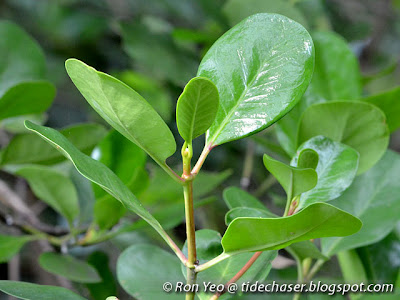The Chengam (Scyphiphora hydrophyllacea) is a nationally common mangrove shrub from the family Rubiaceae.
This rather common mangrove tree can be seen at most of our major mangrove forests, such as Pulau Tekong, Pulau Ubin, Pasir Ris, Sungei Buloh Wetland Reserve, Kranji, Pandan, St John's Island and Pulau Semakau, among others.
It can occur on muddy, sandy and rocky substrates on the landward margin of mangroves forest or on the banks of tidal rivers, but usually on sites that are seldom flooded by the tide or even freshwater.
The shrub has many multiple stems with brownish bark.
It has simple, opposite, leathery, glossy and obovate leaves with rounded tips. The leaf bud consist of two flattened leaves stuck to each other, which eventually open up as they mature.
The flowers occur in dense clusters, and each flower has 4 white lobes tinged pink.
The small fruits are cylindrical and green. Every fruit is ribbed along its length and buoyant.
The wood is hard and is used to make small wooden objects, such as spoons. It is also used for fence posts and firewood. An extraction from the leaf is used to treat stomach problems.
References
- Chong, K. Y., H. T. W. Tan & R. T. Corlett, 2009. A Checklist of the Total Vascular Plant Flora of Singapore: Native, Naturalised and Cultivated Species. Raffles Museum of Biodiversity Research, National University of Singapore. Singapore. 273 pp.
- Giesen, W., S. Wulffraat, M. Zieren & L. Scholten. 2006. Mangrove guidebook for Southeast Asia. RAP Publication 2006/07. FAO Regional Office for Asia and the Pacific & Wetlands International. Bangkok. 769 pp.
- Ng, P. K. L. & N. Sivasothi. 1999. A guide to the mangroves of Singapore 1 : the ecosystem & plant diversity. Singapore Science Centre. Singapore. 168 pp.

No comments:
Post a Comment